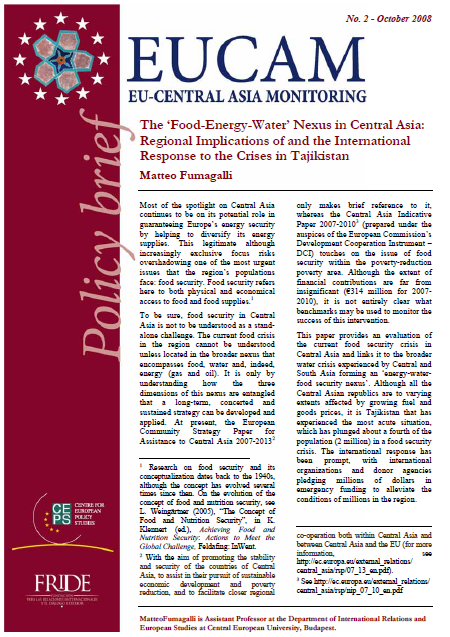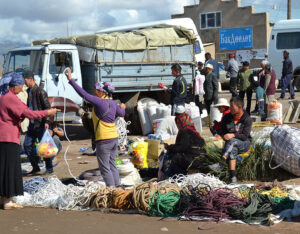The ‘Food-Energy-Water’ Nexus in Central Asia: Regional Implications of and the International Response to the Crises in Tajikistan

Download “The ‘Food-Energy-Water’ Nexus in Central Asia: Regional Implications of and the International Response to the Crises in Tajikistan”
EUCAM-Policy-Brief-2.pdf – Downloaded 737 times – 146.60 KBMost of the spotlight on Central Asia continues to be on its potential role in guaranteeing Europe’s energy security by helping to diversify its energy supplies. This legitimate although increasingly exclusive focus risks overshadowing one of the most urgent issues that the region’s populations face: food security. Food security refers here to both physical and economical access to food and food supplies.1
To be sure, food security in Central Asia is not to be understood as a standalone challenge. The current food crisis in the region cannot be understood unless located in the broader nexus that encompasses food, water and, indeed, energy (gas and oil). It is only by understanding how the three dimensions of this nexus are entangled that a long-term, concerted and sustained strategy can be developed and applied. At present, the European Community Strategy Paper for Assistance to Central Asia 2007-20132 only makes brief reference to it, whereas the Central Asia Indicative Paper 2007-20103 (prepared under the auspices of the European Commission’s Development Cooperation Instrument – DCI) touches on the issue of food security within the poverty-reduction poverty area. Although the extent of financial contributions are far from insignificant (€314 million for 2007- 2010), it is not entirely clear what benchmarks may be used to monitor the success of this intervention.
This paper provides an evaluation of the current food security crisis in Central Asia and links it to the broader water crisis experienced by Central and South Asia forming an ‘energy-waterfood security nexus’. Although all the Central Asian republics are to varying extents affected by growing fuel and goods prices, it is Tajikistan that has experienced the most acute situation, which has plunged about a fourth of the population (2 million) in a food security crisis. The international response has been prompt, with international organizations and donor agencies pledging millions of dollars in emergency funding to alleviate the conditions of millions in the region.
Nevertheless the international community tends to deal with food insecurity in the region, and in Tajikistan in particular, as if the causes were temporary and not chronic. Thus an immediate, but ad hoc response ensues. The proliferation of instruments supposedly dealing with the crisis demands instead a rationalisation of the international community’s handling and the development of a more long-term strategy to address food insecurity in Central Asia. Integrating food security into both the EU Strategy for Central Asia4 and the EU Water Initiative,5 and presenting a systematic approach to dealing with such intertwined issues would be a welcome start.
Introduction
Since the announcement of the UN Millennium Development Goals (ending poverty and hunger being the first among them6 ) food security in the world’s poorest countries has at the same time improved and worsened. As a result of China and India’s sustained economic growth, many more people have access to better salaries and more nutritious food. At the same time, however, about 1.4 billion people live on less than $1.25 a day.7 For them the current global fuel and food crisis could not have come at a worse time.
The rising prices of fuel and food are having a dramatic impact on the lives of millions in Central Asia. This is particularly – albeit not exclusively – the case of Tajikistan’s population of 7 million who have faced a combined series of shocks over the past couple of years.
An insignificant level of domestic gas production and Soviet-era inherited infrastructure mean that Tajikistan is almost exclusively dependent for its gas supplies on its larger and more powerful neighbour Uzbekistan, with whom it has poor relations. Thus, despite the fact that Uzbekistan relies on Tajikistan’s water for its farming and cotton industry (as well as for providing its population with drinking water), it nevertheless imposes high purchase prices and uncompromising payment deadlines on Tajikistan. Supply cuts have not been uncommon in the past, but the combination with a series of natural disasters that have plagued the country since 2007 have taken their toll on the poor country’s population. First a particularly harsh winter (with temperatures plunging to -15° C in towns and up to -25° C in the countryside) caused great damage to the water and electricity system. This, along with the abovementioned gas supply cuts meant that even the population in the capital Dushanbe lived with two hours or so of electricity a day for the entire 2007-2008 winter up to the end of February. Heating barely functioned. A locust invasion and then a drought between the spring and summer of 2008 meant that crops and seed stocks depleted, and livestock died. This caused immense damage to the rural population, which since the collapse of the Soviet system has increasingly relied on production for domestic consumption and selfsufficiency. In cities, the global rise in food prices and the country’s reliance on grain imports from Russia and Kazakhstan saw a growing number of people unable to afford food.8
In a May 2008 Emergency Food Security Assessment, the UN World Food Programme (WFP) estimated that the food crisis had left two million Tajikistani citizens in a situation of food insecurity, that is, unable to access food, either because of shortage of supplies or out of the inability to afford it. Tajikistan remains the poorest of the post-Soviet republics and about 64% of the population lives below the poverty line. Rampant official and unofficial unemployment, meagre salaries (when paid) have led up to two million people to leave the country and find (mostly unskilled) jobs in Russia and more recently in Kazakhstan. Remittances sent from migrants abroad have, in conjunction with humanitarian aid, allowed the population to cope with an unimaginably harsh series of economic and natural disasters.
This, along with the state’s chronic lack of resources, poor economic planning and concentration of power in the hands of a few, have left the population increasingly exasperated but most crucially plunging deeper into poverty and hunger.
Response from international organisations, donor agencies and external powers (including Russia, China, Iran and even Kazakhstan) has been prompt, and the emergency situation has been dealt with through emergency measures. More than $30 million have been pledged and have begun to be channelled to rescue Tajikistan’s population from an ‘energy and food crisis’. Prompt response is no strategy, however. The causes of food insecurity in Tajikistan and Central Asia more broadly are chronic, rather than temporary, which means that they are here to stay. The international community should therefore work to ensure that future recurrences will not have such dramatic proportions.
This paper first gives an overview of the current food crisis in the Central Asian region. Next the focus shifts to Tajikistan as this is where the food insecurity is most acute. The origins of food insecurity are examined. What follows then is a discussion of the international response to the crisis, paying attention to the way in which international organisations have reacted to the crisis. European assistance receives particularly emphasis. The paper concludes with some recommendations as to how the EU’s role could be enhanced and its contribution made more effective.
The food crisis in Central Asia
Central Asia has not been exempt from the combined global fuel and food crisis that has affected the developed and developing world alike.9 Prices of energy (gas and electricity) have risen dramatically. Reliance on food imports (especially grain) from abroad or some of the neighbouring countries (Kazakhstan) meant that when suppliers faced domestic shortages and decided to support a ban on exports earlier this year10 the poorer republics of the region were most affected. In addition, harsh weather conditions led to circumstances where although needed for agricultural purposes in downstream countries (Uzbekistan, but also Turkmenistan and southern Kazakhstan) water had to be converted into electricity during the winter to ensure some domestic heating. As a result of this and of damage to water distribution systems, water levels in the reservoirs in Kyrgyzstan and Tajikistan (from where almost all of Central Asia’s water flows) lowered dramatically on the one hand, and the flow to the neighbouring countries declined dramatically. This left very little water for the summer and for farming. A vicious circle of shocks all feeding into each other followed setting the stage for the current crisis affecting, simultaneously, food and energy security in the region.
Food security, alleviating poverty and an environmentally sound use of natural resources are vital to the sustainable economic growth of Central Asia.11 Policy and institutional reform have been slow, however, and overall positive macroeconomic indicators often disguise a bleaker picture in terms of living standards of the ordinary people. What is more, similarly to neighbouring Afghanistan, Tajikistan is still coping with the consequences of the 1992-1997 civil war12 in terms of disruption of food production and transportation (from abroad and internally).13
The causes for the current food crisis in the region are both chronic (structural) and contingent (legacy of the war, slowness of the governments to reform agricultural and industrial sectors). This aside, what precipitated the food crisis in 2008 was Kazakhstan’s decision to ban its grain exports following concerns with domestic shortage. As Kazakhstan is the region’s main source of grain, the region was plunged further into a state of food insecurity. It was an extremely welcome step when Kazakhstan reconsidered its position and announced in May its readiness to help Tajikistan to cope with the emergency.
Food insecurity: Tajikistan’s multiple crises
Of the five Central Asian countries, the most exposed to the food crisis is Tajikistan. The reasons for this are multiple and in essence are a result of a combined series of shocks that have affected the country over the past couple of years.
Tajikistan is a mountainous and landlocked country, home to very few industries (aluminium production continues to dominate the country’s GDP) and the source of only limited exports. The mountainous nature of the small republic means that only 7% of the land is usable for agricultural purposes. With no oil and a barely perceptible production of natural gas, Tajikistan is entirely dependent on its neighbours for energy and food supplies.
Even in pre-crisis assessments, Tajikistan performed poorly on most socio-economic levels. The UN Development Programmes ranks the country at the 122nd place in its 2005 Human Development Index. About 64% of its population live below the poverty line. High unemployment and equally high underemployment mean that the population has relied for a large part of the postSoviet period on international aid and on remittances from labour migrants abroad.
Its reliance on food imports makes Tajikistan a ‘fooddeficit country’. According to a study jointly conducted by the government of Tajikistan, UNICEF, FAO and WFP in the spring of 2008, about 1.68 million people living in the countryside are considered to be food insecure (34% of the rural population). Of these, 540,000 people are seen as ‘severely food insecure’ (11% of rural households), and 1.14 million were moderately food insecure (23% of rural households).14 The situation is not much better in urban settings: 200,000 people (15% of the urban households) are considered to be severely food insecure and, an additional 300,000 (22% of the urban households) are viewed as moderately food insecure. About 27% of the severely food insecure people spend up to 80% of their income on food.15
Back from the brink… and back?
The 1997-2007 decade saw Tajikistan emerging from the destruction brought by the civil war and embark on a slow process of post-conflict reconstruction and recovery, marked by some degree of stability, political and institutional, as well as some macroeconomic growth.
In recent years, the country has reported robust growth, primarily owing to increased cotton, gold and aluminium export levels. This notwithstanding, progress at macroeconomic level has not translated into an increase in the living standards of the local population. Ordinary citizens have increasingly felt frustrated by the socioeconomic decline and disempowered from the government’s reluctance to share power. As a result, for the first time in years the country has experienced a wave of protests and in both March and June 2008, protests broke out in Gorno-Badakhshan.16 Another area of concern is the northern Sughd region (formerly Leninabad). The richest region in the country in Soviet times, it is now home to some of the country’s poorest cities (including the region’s capital Khujand). Poverty in the countryside is somehow more evenly spread in the country between Sughd, the Districts under Republican Subordination, Khatlon and Gorno-Badakhshan (see the figure below). Political and economic regional imbalances make for a conflict potential that would certainly destabilise the country.
Problems are not purely domestic. The periodical tensions with Uzbekistan have resurfaced following the latter’s decision to increase fuel prices (gas) and demand prompt payment for supplies in 2007 and 2008. Once again, gas supplies were cut off, leaving thousands of houses in a freezing cold.
Dealing with and ensuring food security: The international response
Given the scale of the food crisis, Tajikistan did not have the resources and capacity to respond adequately. Freezing temperatures in winter months and drought in the summer also meant that water levels (for both drinking and farming purposes) lowered significantly, leaving the population in the cold during the winter and with little access to water during the summer.
Helping the population to cope with all this was left to donor agencies and international organisations which mobilised extensive funding through international appeals. Resources were directed at preventing a further deterioration of food insecurity.
As the crisis became apparent in February 2008, the Food and Agriculture Organisation launched a $27 million Compound Crisis Flash Appeal for Tajikistan (by August $14 million had been mobilised). Through USAID, the United States provided Tajikistan with $8 million-worth of humanitarian aid for the FY2007 and FY2008. An additional $14 million had been gathered through additional appeals.
Apart from the intervention of IGOs and NGOs, other actors played an important role in helping Tajikistan cope. Kazakhstan, one of the world’s largest grainexporting countries, came up with an emergency plan to assist Tajikistan, de facto partly reversing an earlier decision to ban all grain exports due to its necessity to face domestic shortages.
In a bilateral summit Tajikistan’s President Imomali Rahmon and Kazakhstan’s Nursultan Nazarbaev announced in May 2008 that Kazakhstan would create a $100 million investment fund and that it would endeavour to continue its food supplies to Tajikistan. This decision may reflect Kazakhstan’s renewed ambitions to take on a leading role in the region, also as a result of its booming economy and the prestige that followed the announcement of its chairmanship of the Organisation for Security and Cooperation in Europe (OSCE).
The European Union played no minor role in helping Tajikistan face repeated crises. One of the country’s main suppliers of humanitarian aid since 1993, the EU has continued to channel aid through its humanitarian programme ECHO (and DIPECHO for dealing with natural disasters, which are common in Tajikistan). ECHO funding amounted to ca. €165 million over the period 1993-2006.
The EU Strategy and the accompanying Regional Strategy Paper for to Assistance Central Asia laid considerable emphasis on how Europe would benefit from the region’s security and stability. The Strategy also contained an important point on the role that hydropower production and distribution could play to this end. That said, sections of the strategies often seemed disconnected, with water falling within the remit of two separate sections, one on energy and the other on environmental sustainability. No doubt the areas are conceptually distinct, but the missing conceptual link between these two spheres reflects an approach that is still not holistic in addressing the multiple challenges the region faces. As noted later in this paper, the Assistance Strategy Paper considered food security only marginally.
The EU’s evolving approach in this regard is to be welcomed. As ECHO has now approached the end of its life, European assistance to the country and the region will take place through the Commission’s DCI (Development Cooperation Instrument). DCI’s main objective is the eradication of poverty, in pursuit of the first of the UN Millennium Development Goals. This is reflected in the fact that the Central Asia Initiative Paper highlights how most of the European Commission’s assistance to Tajikistan would be concentrated on priority area no. 2 (poverty reduction). The DCI is structured along geographical lines, and the 2007-2010 Regional Indicative Programme for Central Asia has a budget of ca €314 million (average yearly budget: €78.5 million 17) to be distributed to the region until 2011 (€719 million for 2007-2013). Improvement of food security constitutes one of the five thematic programmes of the DCI, which signals the EU’s new approach to aiding development by adopting LRRD (Linking Relief, Rehabilitation and Development) as the guiding philosophy. One could also presume that of the bilateral Priority Papers signed by the EU and each individual state (the documents are not yet available), at least the one on Tajikistan, if not all, would address the question of food security in some detail.
Beyond Tajikistan: The regional implications of the food crisis
The food crisis in Tajikistan and the broader region should not be taken in isolation. As former World Bank Director for Europe and Central Asia Johannes F. Linn, emphasised by the food crisis should be understood as just one dimension of a combined series of crises which affect – alongside food security – also energy (oil and gas) and water. 18 Because of the entangled nature of the resource management system of the region, problems in one area easily spill over on the next, generating a mutually reinforcing spiral of insecurity which starting from one republic affects all the neighbours in Central Asia, with additional impacts on Afghanistan and Pakistan to the south, since these fall within the Amu Darya-Syr Darya water basin and receive water (and potentially) electricity from the north.
In other words, water shortages in Tajikistan and Kyrgyzstan mean that less water is available for farming. Rice and cotton are water-thirsty crops. Irrigation systems are outdated with frequent leaks; controls of how farmers make use of the water are poor. Water shortages at the origin have a devastating impact on harvests, causing great difficulty in obtaining access to food which needs to be otherwise imported. This is where the local (shortage and mismanagement) meets the global (rising fuel and food prices). Food imports are – of course – expensive and higher food prices and/or lower supplies render the local population more food insecure. Or, seen from a different angle, a shortage in energy supplies (gas for heating purposes) means that more water has to be taken from reservoirs to generate electricity during the winter. This in turn triggers the dynamics described above.
The current food crisis, although particularly acute in Tajikistan, is not confined to that republic. It affects Uzbekistan and Kyrgyzstan, both of which in fact now expect a very rough 2008-2009 winter. Thus, intertwined issues require not only a joint response by external powers, donors and international organizations (however necessary this may be), but also a comprehensive assessment of how the region can extricate itself from a situation of chronic food and energy insecurity that would otherwise just repeat itself in a few years time.
Recommendations
This year has seen the first manifestations of protest and unrest in Tajikistan for several years. Social and economic instability is widely predicted to intensify over the coming months, as a result of the rise in food and fuel prices, rampant inflation and a continuous decline in living standards, alleviated only by the remittances sent home by labour migrants abroad (in Russia and Kazakhstan primarily). Moreover, the ceaseless flow of economic and natural disasters that have succeeded each other, ultimately feeding into each other, have made the situation in Tajikistan of urgent concern to its neighbours and powers external to the region.
To address the worsening food crisis in the country and the broader Central Asian region, a number of measures, some of which concern the whole international community while others are of specific interest to the EU, need to be taken, as outlined below.
To the international community
• Develop an integrated strategy that addresses poverty and food security in both urban and rural settings. Urban and rural households face similar challenges, despite their distinctive traits. Migration from the countryside to the cities puts additional pressure on the urban centres’ capacity to guarantee food security to local households. While the population in the countryside has reverted to production for domestic consumption, in city dwellers rely on the market. Food shortages and rising prices put urban stability at serious risk.
Ease the disputes between Uzbekistan and Tajikistan. While historical controversies are not likely to be resolved any time soon, bilateral issues concerning border security, but also trade and energy agreements require an urgent solution to prevent mutual provocations from triggering broader responses and consequences. While Uzbekistan needs to feel secure in its borders (militant spillover is a constant fear in Tashkent), disruptions of gas supply and rapid increases in commodity prices are not sustainable for the Tajik economy at this time. Building infrastructure to bypass Uzbekistan is likely to require funds and time. This possibility should be explored, as well as diversifying energy supplies, but international organisations with a focus on conflict management and resolution should offer guidance on ending the long-standing disputes between the two neighbours.
• Closely cooperate with the Tajikistani government to monitor on policy reform. While documents such as the World Bank’s Poverty Reduction Strategy19 seem to suggest that the authorities are aware of the urgency of institutional and policy reform in crucial areas such as agriculture, international actors should ensure that reforms are not only announced, but adopted and implemented.
To the EU
• Work in synergy with the other political actors that have a stake in Tajikistan’s stability. The EU relations with Russia are frosty at best. Focusing on developing a joint strategy with the Kremlin (and in fact with all of Tajikistan’s neighbours and Iran) would provide an opportunity for building mutual trust on a very specific issue between powers that are otherwise reluctant to agree on anything. Given the importance of the ‘Tajik question’ for Russia (which needs a constant flow of foreign labour, but not an inundation of refugees fleeing hunger), there is space for making progress in providing a coordinated response to the Tajik crisis. Kazakhstan’s leading economic role in the region and its good relations with both Russia and the EU should make the involvement of Astana in the elaboration of a concerted strategy a priority. Kazakhstan’s commitment to ease Tajikistan’s hardships this year makes the country a particularly important actor in dealing with the current regional food crisis (although it too may eventually not be spared its effects).
• Integrate food security more explicitly into the EU Strategy on Central Asia. The issue was worth a quick mention in the Commission’s Regional Strategy Paper for Assistance to Central Asia 2007-2013, which afforded little space to it and essentially groups it under the rubric of disaster preparedness.20 The situation has somewhat improved in the CA Initiative Paper (within the DCI) where it falls within the second priority area (poverty reduction). Integration of food security in the EU Strategy for Central Asia would and should move beyond the traditional humanitarian aid/emergency approach that has defined European assistance to Tajikistan and the whole region over the years.
• More emphasis should accordingly be paid to how the EU Water Initiative could contribute to enhance food security in the region. In particular it is important to develop an integrated approach that treats energy, water and food security as intertwined issues demanding a complex and multifaceted response rather than security challenges to be addressed separately. 20 See p. 24 of the Regional Strategy Paper for Assistance to Central Asia 2007-2013.
Conclusion
Because of the complex and long-term nature of the effort, as well as the significant financial implications, action to reduce food insecurity in Central Asia needs to be concerted and reflect long-term strategic planning rather than an ad hoc response to an emergency. The domino effect that follows from the emergence of a crisis in one country and/or in one area (food, water, gas) shows that the response has to be both country-specific and regional in its scope. The potential fallout of yet another crisis would be severe and would affect the entire region.
References
1. Research on food security and its conceptualization dates back to the 1940s, although the concept has evolved several times since then. On the evolution of the concept of food and nutrition security, see L. Weingärtner (2005), “The Concept of Food and Nutrition Security”, in K. Klennert (ed.), Achieving Food and Nutrition Security: Actions to Meet the Global Challenge, Feldafing: InWent.
2. With the aim of promoting the stability and security of the countries of Central Asia, to assist in their pursuit of sustainable economic development and poverty reduction, and to facilitate closer regional co-operation both within Central Asia and between Central Asia and the EU (for more information, see http://ec.europa.eu/external_relations/ central_asia/rsp/07_13_en.pdf).
3. See http://ec.europa.eu/external_relations/ central_asia/rsp/nip_07_10_en.pdf
4 Adopted at the European Council meeting in July 2007, the Strategy provides the overall framework for EU relations with Central Asia (see http://www.auswaertigesamt.de/diplo/en/Europa/Aussenpolitik/ Regionalabkommen/EU-CentralAsia-Strategy.pdf).
5 Launched at the 2002 World Summit for Sustainable Development (WSSD) in Johannesburg, the EU Water Initiative (EUWI) aims to contribute to the achievement of the Millennium Development Goals and WSSD targets for drinking water and sanitation, within the context of an integrated approach to water resources management (for more information, see http://www.euwi.net/).
6 The aim would consist of halving the number of people living with less than $1 a day by 2015. For more on the MDGs, see http://www.un.org/millenniumgoals/.
7 World Bank data 2008.
8 Between 2007 and 2008, mutton, cabbage, bread and wheat prices increased by 44%, 281%, 100% and 106%, respectively (USAID Global Food Insecurity and Price Increase Update No. 2, 21 May 2008).
9 Suffice it here to note the importance dedicated by Western governments to ‘their own’ food security (see the UK Food Security initiative by the UK policy think tank Chatham House).
10 J. Lillis, “Kazakhstan: Grain exports ban stokes inflation fears elsewhere in Central Asia”, Eurasianet, 16 April 2008.
11 S. Babu and P.Pinstrup-Andersen, “Achieving Food Security in Central Asia – current challenge and policy research needs”, Food Policy, 25, 2000, pp. 629-635; V. Rhoe, S. Babu and W. Reidhead, “An Analysis of Food Security and Poverty in Central Asa – Case study from Kazakhstan”, Journal of International Development, 20, 2000, pp. 452-465.
12 In the early 1990s, social and political order collapsed in Tajikistan when the liberalisation initiated by former Soviet President Gorbachev led to a sudden shift in power relations in the republic. As a result of these changes, the precarious political balance put in place by the Soviets to rule the diverse regions of the republic was shattered and the country virtually imploded. A sudden and particularly brutal civil war erupted in 1992, which eventually left more than 50,000 dead and at least half a million people internally or internationally displaced. Although the bloodiest phase of the hostilities was over by 1993, the conflict continued until 1997, when a peace agreement was signed by representatives of the government forces and opposition factions. The Peace Accord set in place a power-sharing agreement where, at least formally, the government conceded to the opposition a role in the power structure and institutions. For more on the Tajik Civil War, see C. Barnes and K. Abduillaev (eds), Politics of Compromise: The Tajikistan Peace Process, London: Conciliation Resources, 2001.
13 On the impact of war on food security in Afghanistan, see P. Clarke, “Food Security and War in Afghanistan”, Development, 43(3), 2000, pp. 113-119; P. Chabot and P.A. Dorosh, “Wheat markets, food aid and food security in Afghanistan”, Food Policy, 32, 2007, pp. 334-353.
14 See the May and July 2008 UN WFP Emergency Food Security Assessments in urban and rural areas of Tajikistan , (http://home.wfp.org/stellent/groups/public/documents/ena/wfp 187898.pdf and http://home.wfp.org/stellent/groups/public/documents/ena/wfp 188194.pdf) (accessed on 30 September 2008).
15 Ibid.
16 Asia-Plus, 18 June 2008; E. Marat, “Khorog residents spark rare protest against the government”, Eurasia Daily Monitor, Jamestown Foundation, 20 June 2008.
17 Assistance can be broken down at country level as follows (€219.8 of the total €314 million, the remaining being allocated to promotion of regional cooperation): Kazakhstan €44 millon; Kyrgyzstan €55 million; Uzbekistan €32.8 million; Turkmenistan €22 million; and Tajikistan €66 million (Central Asia Indicative Programme 2007-2010, p. 4).Of the €66 million allocated to Tajikistan it is expected that €29.7 million would be drawn up in the poverty reduction area.
18 J.F. Linn, “The Compound Water-Energy-Food Crisis Risks in Central Asia: Update on an International Response”, Brookings Institution Commentary, 12 August 2008, (http://www.brookings.edu/opinions/2008/0812_central_asia_li nn.aspx) (accessed 30 September 2008).
19 A Poverty Reduction Strategy Paper (PRSP) describes a country’s macroeconomic, structural and social policies and programmes to promote growth and reduce poverty, as well as associated external financing needs. They are prepared by the government through a participatory process involving civil society and development partners, including the World Bank and the International Monetary Fund.
20 See p. 24 of the Regional Strategy Paper for Assistance to Central Asia 2007-2013.







